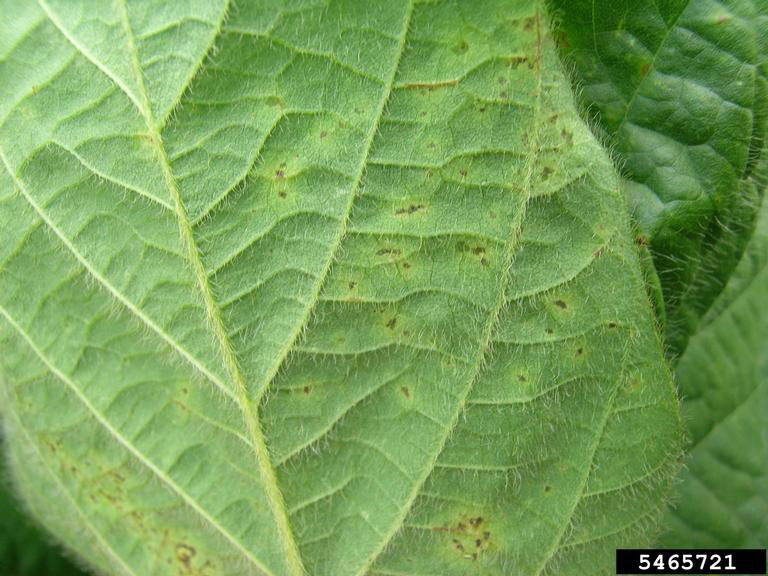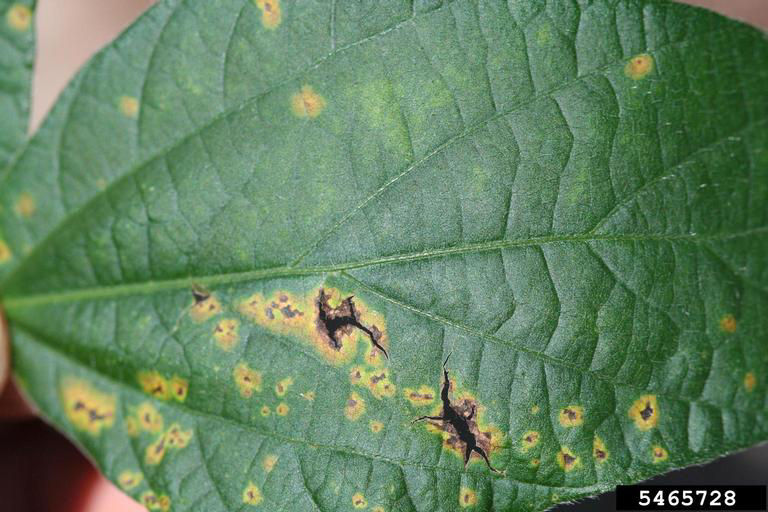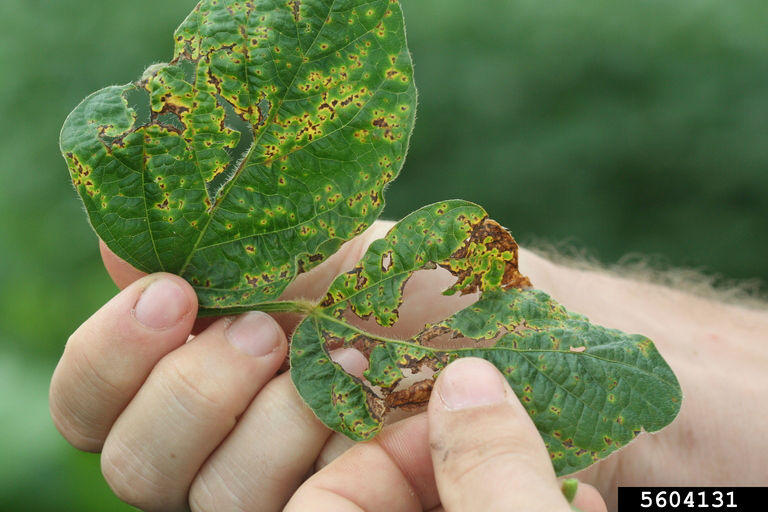3 MIN READ
Bacterial Blight in Soybean
November 10, 2023
- Bacterial blight is favored by cool (70 to 80 °F), wet weather and is inhibited by hot, dry weather.
- Rotating away from soybean or planting soybean products that are tolerant to bacterial blight is recommended for problem fields.
- Foliar fungicide application are not effective in controlling bacterial blight.
Bacterial blight of soybean is the most common bacterial disease of soybean and is caused by the bacterium Pseudomonas savastanoi pv. glycinea.1 The disease is favored by cool (70 to 80 °F), wet weather and is inhibited by hot, dry weather. Bacterial blight seldom causes significant yield loss.2
Disease Cycle
The bacterium overwinters on crop residue and infection usually occurs when the pathogen is carried by splashing or wind-driven rain from infected plant residue to soybean leaves. Disease outbreaks usually follow a rain event with high winds. Bacteria can enter the plant through natural openings (stomata) or plant wounds. The pathogen can spread from infected leaves to uninfected leaves when they rub against one another during cultivation (especially when there is dew), rain, or wind, though the leaf surface must be wet for infection to occur through natural openings. Additionally, seedling infection can occur by planting infected seed.1,2,3
Foliar Symptoms
Bacterial blight lesions may first appear on the cotyledons, usually at the margins. These lesions enlarge and turn dark brown as the tissue collapses. Young seedlings grown from infected seed commonly are stunted, blighted, and usually die. Infected young leaves frequently are distorted, stunted, and chlorotic.2
Typically, symptoms can be observed 5 to 7 days after soybean leaves are infected.1 Bacterial blight can be identified by angular lesions which begin as small yellow to light-brown spots on the leaves (Figure 1). As the disease progresses, the centers of the spots turn reddish-brown to black and dry out. These dark colored spots become surrounded by water-soaked margins bordered by yellowish-green halos (Figure 2). In advanced stages, lesions can enlarge and possibly coalesce with other lesions producing large, irregularly shaped dead patches (Figure 3). Frequently, the leaves are badly shredded after strong winds and/or hard rains. This gives affected leaves a very ragged appearance3 (Figure 4).




Younger leaves are more susceptible to infection, and symptoms usually develop first in the upper to middle part of the canopy. However, bacterial blight is found primarily on leaves that developed during cooler weather when conditions favored the disease. As the season progresses, leaves above the infected region are often disease-free, primarily because of higher temperatures during their development.
Leaf symptoms of bacterial blight may be confused with Septoria brown spot (also known as Septoria leaf spot). However, bacterial blight will usually be in the mid-upper canopy and have green leaves below the affected area while Septoria brown spot tends to appear lower in the crop canopy.
Symptoms – Pods
Soybean pods, petioles, and stems are also susceptible to bacterial blight. Initially, lesions on the pods are small and water-soaked; however, after enlarging, they merge to involve much of the pod. Lesions eventually turn dark brown to black. Seeds within the affected pods may also become infected and coated with a slimy bacterial growth. Stored seeds may appear healthy or may develop a variety of symptoms including shriveling, sunken or raised lesions, or slight discoloration.
Management
The most effective management practices to reduce the impact of bacterial blight on yield potential are crop rotation or selecting soybean products that are resistant or tolerant to bacterial blight. Plant fields with a known history of bacterial blight to a non-host crop such as corn, sorghum, alfalfa, clover, or cereal grains for at least one year.
Additional management practices include incorporating soybean crop residue after harvest with tillage when feasible. Tillage effects on soil moisture and potential erosion should be taken into consideration. Also, avoid cultivation when foliage is wet.3
Foliar fungicides seldom provide an economic benefit as bacterial blight is caused by a bacterial pathogen. Some copper-based bactericides are labeled for control of bacterial blight on soybean; however, application needs to occur early in the disease cycle to be effective.2
Sources:
1 Hartman, G.L., Sinclair, J.B., and Rupe, J.C. 1999. Compendium of soybean diseases, 4th edition. American Phytopathological Society Press.
2 Giesler L.J. 2011. Bacterial diseases of soybean. NebGuide G2058. University of Nebraska – Lincoln Extension. https://extensionpublications.unl.edu/assets/pdf/g2058.pdf
3 Giesler, L. Bacterial blight. CropWatch. University of Nebraska-Lincoln https://cropwatch.unl.edu/plantdisease/soybean/bacterial-blight
Malvick, D. 2018. Bacterial blight on soybean. University of Minnesota Extension. https://extension.umn.edu/pest-management/bacterial-blight-soybean
Web sources verified 10/4/2023. 1311_61341






